'Musa' is the link between my attempts at growing tropical plants amongst other more 'normal' plants, 'Musa' being the botanical term for the banana genus, and the name of a mountain close to where we holiday in Turkey - Musa Dag. This blog will be mainly about the garden and its plants including attempts at growing bananas, colocasias etc. here in the UK. Other subjects may/will creep into this blog including holidays in Adrasan, music, food and other meanderings.
Farwell!
It has been an experiment and one that has been enjoyable, to a point. But, I have learned a lot and will we back one day. Perhaps a blog on the subject of stoats or something more specific - I don't know. Certainly, there are far better and knowledgeable people than me on the subject of plants and gardens and I have failed to add the intended wit to make this blog interesting. 'Work' is bad enough without adding another burden and that is what it has become - "What shall I write" - "I should write something".
So, goodbye and thanks to anyone who found interest in my meanderings.
This blog will stay open for the next few weeks and then I will delete it.
Rob
Under Hostas towards Black Bamboo Canes

Under Hostas towards Black Bamboo
Originally uploaded by emagen
Further to my previous post, I took this photograph with the camera underneath some hostas looking towards Phyllostachys nigra (Black Bamboo). I think the black canes show up well and you can see the emerging new shoots.
I've been experimenting with taking photographs from underneath plants. Some of the results can be seen on my Flickr photostream in my 'Underplants' set. (Follow the link next to the above photo.)
New Bamboo Shoots
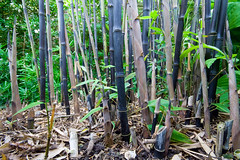
New Bamboo Shoots
Originally uploaded by emagen
The new shoots of Black Bamboo or Phyllostachys nigra are thrusting upwards from the ground.
This year it looks like the new canes are going to be up to 3/4 inch in diameter. The width of each new shoot will be the same as when it is fully grown (if that makes sense!). Last years new canes were not particularly thick or numerous. I'm not sure why this year should be a more productive year as I have not changed the way I cultivate the plant.
Every year, in the autumn, I put a thick layer of rotted compost from the heap all around the canes. In the spring I apply liquid feed and ensure the soil is kept moist. Throughout the year I cut out any small canes in order to keep the clump from becoming too chocked. I always remove the lower branches from each new cane as it grows (I call this 'shaving its legs'). Removing the lower branches makes the black canes more visible although it is important to note that the canes do not turn black until their second year. I'm not sure if removing the lower branches does the plant any harm but its canes are now over 12 feet high so it seems quite healthy.
I grow Phyllostachys nigra in dappled shade and I think this prevents it wandering too far although this year some of the new shoots seem to have travelled quite far.
Beschorneria yuccoides about to flower
It is with a certain amount of sadness that I have to announce that my Beschorneria yuccoides plant is about to flower.
I’ve grown this plant for a number of years and I really, really like it. It looks a bit like a Yucca but despite its looks, it does not have sharp spikes on it hence it can be grown close to a path. I like its geometric shape and its blue/grey/green leaves.
The flower bud looks enormous and I’m surprised that there are another two buds developing.
The flower spike should reach 6ft and, I’ve read, should be quite spectacular. I’ll probably (almost certainly) post a picture when it actually flowers.
So, why am I so sad? Because, after flowering the main plant will die! OK, so there are now small baby plants around the base but it will take some time for these to grow and I will need to separate them – I think the plant looks best growing as a solitary specimen.
Its been a good plant and I will miss it.
Garden, June 3rd 2009
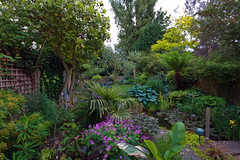
Garden, June 3rd 2009
Originally uploaded by emagen
Photograph of the top part of the garden taken late evening yesterday. Every day there is something coming into bloom. The garden is still in Spring mode with the 'big stuff' yet to make a mark. Mind you, my bananas are having to start from ground level this year.
Hosta - Sun and Shade
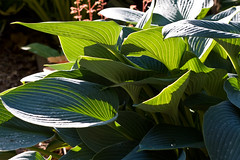
Sun and Shade
Originally uploaded by emagen
I can't resist adding this photo to the blog. As I've said before, I'm hopeless at making notes of or remembering the names of all the different Hosta in the garden (about 40).
But this time of year is probably the best time for Hostas, they look fresh and, if you are lucky, not too full of slug holes.
The photograph was taken in the early evening with the sun shining through the blue-green leaves showing up the veining.
Campanula garganica 'Dickson's Gold'
Campanula garganica 'Dickson's Gold' (Adriatic Bellflower) is just beginning to flower and I think the plant looks best when it is in bud. The emerging blue buds look really great amongst the almost yellow leaves and create a sort of haze effect. I can’t resist trying to get a decent photograph of it and my Flickr site has many attempts on it.
I grow this plant on a narrow wall bed in a fairly sunny site and the extra height plus it being just outside the glass back doors enable it to be seen. Of course, I have to admit, I didn’t think of this when I planted it 10 years ago – it just turned out to be a lucky placement.
Campanula garganica 'Dickson's Gold' is a low growing, rock garden, perennial type of Campanula. I have several other ‘rock garden’ types but they tend to be invasive as does garganica but this ‘Dickson’s Gold’ variety behaves itself very well. My plant now covers about 3 square feet and is about 3 inches high. This variety has the added advantage of its bright yellow-green leaves that give interest even when the plant is out of flower.
Tradescantia pallida 'Purpurea'
I am surprised to find that Tradescantia pallida 'Purpurea' has made it through last winter unaided.
I’ve always thought of this plant as a houseplant and, therefore, tender. I originally bought the plant as part of my experiments of growing so called ‘houseplants’ as summer bedding. It is planted in a bed that houses bananas, a palm and Colocasias and has survived for the last 3 years but I was certain last winter’s cold would kill it.
I noticed, at the weekend, that it had survived and below is a photograph of new shoots rising from the soil.
I’ve since read that Tradescantia pallida 'Purpurea' is actually supposed to be quite hardy so I have learnt something! I also now know that it is sometimes referred to as Setcreasea pallida ‘Purpurea’. I also now know that the plain green leaved form is an invasive weed in Australia.
Anyway, the plant looks tropical and most unlikely to survive the UK climate, hence it goes well in a tropical planting of bananas and the like.
Pond May 2009
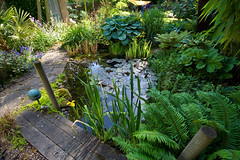
Pond May 2009
Originally uploaded by emagen
The pond is now full of life. The big goldfish (Wattle), the breeding herd of minnows, the newts and the tadpoles are all competing for food and probably eating each other.
A wide selection of birds use the pond for drinking from and bathing in the shallow areas. The blackbirds behave more like 'waders', stalking tadpoles and fishing them out to eat.
The minnows are definitely breeding and I hope there will soon be baby minnows or perhaps they are called 'fry'. Last year there didn't seem to be any babies and I think this could either be due to the newts eating the eggs or me cutting back the rampant waterlily which may have had the eggs on. In previous years the minnow herd has reached vast numbers but a visiting kingfisher keeps the numbers down.
I dug the pond about 9 years ago and it is amazing how quickly frogs and newts have colonised it.
The plants and ferns around the edge are now in full leaf. The last plant to come into full leaf has been the Rodgersia (seen centre-right of the photo).
Maintaining the pond is quite time-consuming particularly in early spring when pond weed and algae grow quickly. It gets easier in the summer, I guess because the waterlily cuts down the amount of sunlight and inhibits the growth of pond weed.
I never intended to have goldfish preferring a more natural pond but my late father bought me a pair of them. I called them Wattle and Daub, sadly Daub died a couple of years ago leaving Wattle to get fat alone. My wife thinks I spoil Wattle! But I think she is just jealous. Wattle is a true friend.
Colocasia esculenta emerging
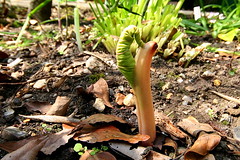
Colocasia esculenta emerging
Originally uploaded by emagen
The photograph is of a leaf shoot of Colocasia esculenta emerging from the soil (taken today). I'm quite surprised how well these plants manage to overwinter without protection. I always keep some plants / tubers in my temporary plastic greenhouse but I lose most of them to rot. I think I will give-up over-protecting them and let them take their chances outdoors. If they can survive last winter then I need not worry.
Having said that - Was last winter really that bad? Sure, we had snow but not really that much and winter seemed to start earlier. But I'm sure my pond spent less time covered in ice than the year before and the year before that. Also the better Spring weather started earlier and we have not had any damaging late frosts.
I'm sure my bananas would disagree though. Where once stood mighty bananas to 12ft, now there are only new shoots emerging from the ground.
Is Your Tree Fern Dead?
I know from my stats page that many people find their way to this blog to seek advice on their Tree Ferns and in particular Dicksonia antarctica. It seems that Tree Ferns all over the UK have suffered due to the very cold winter. The questions people are seeking an answer to include:
- Is my Tree Fern Dead?
- My Tree Fern has no fronds.
- How do I know if my Tree Fern has died?
- My Tree Fern has only a few fronds.
- Why has my Tree Fern not got many fronds?
- Should I cut off dead fronds?
I do not claim to be an expert on Tree Ferns (or anything else for that matter) – so I set off on the Interweb to see if I could find answers to the above questions. I found lots of expert advice on the cultivation of Tree Ferns including how to protect them over winter. But I could not find anything about cold-damaged Tree Ferns or any advice on how to nurture a frost damaged Tree Fern back to life, if indeed, that is possible. For myself, I would like to find advice on what to do about my smaller Tree Fern that has, so far, only put up 2 new fronds this year.
So if there is an expert out there who knows some of these answers please could you use the comments section at the bottom of this posting to share your wisdom.
I have 2 Tree Ferns (Dicksonia antarctica), one 6ft tall and the other 3ft tall. The tallest one is quite exposed to both wind and sunlight and despite losing all its fronds to frost has now put up 20+ new fronds. The shortest one is more sheltered from the wind and sunlight and even has a tall bamboo growing next to it giving increased shelter but this one has only put up 2 new fronds so far this year. Both had some dry leaves and fronds stuffed over their growing point. It seem then that size must be an important factor in getting through a cold winter.
My smallest tree fern, the one in trouble, seems to have either some dead coils of fronds at its heart or somehow the growing area is blocked by the stems of dead fronds. I wonder if some of the cause of my problem is that some of the fronds have been killed by the frost before that were able to naturally bend outwards and downwards away from the centre of the central well of the trunk? I wonder too if dead, embryonic fronds are similarly blocking the central well and stopping the development of new fronds?
I think my non-expert advice for anyone wondering if their Tree fern is dead is:
- To not assume death and continue to keep the trunk moist. Perhaps there is a chance of recovery.
- To not cut off dead fronds unless absolutely sure that there is no life in them.
Sorry that I can’t be of more help but perhaps an expert will give us
some advice.
Salvia microphylla ‘Cerro Potosi’, Aeonium ‘Zwartkop’ and Humulus lupulus 'Aureus'
Salvia, Aeonium and Hop (left to right). Picture taken this morning.
At the risk of continuing to be boring . . . . . Salvia ‘Cerro Potosi’ . . . . what a fantastic plant / shrub! I keep trying to get a decent photo, I can do OK on getting a good shot of individual blooms but can’t seem to get a shot of the entire shrub that does it justice. Above is yet another attempt! The plant pictured is in a large pot just outside the backdoor which means that you brush against it, releasing the scent of blackcurrants from its leaves. It grows in other parts of the garden plated in the soil and is very, very hardy. It flowers from April to November and only requires some pruning to stop it becoming too scruffy.
Also in the shot are Aeonium ‘Zwartkop’ and the yellow-leaved hop, Humulus lupulus ‘Aureas’.
The strong winds have abated and there has been some warm sunshine. Everything is growing with vigour!
For the first time for many years, I’ve treated the back lawn with weedkiler. The lawn has large amounts of moss in it and since treatment the moss has turned black. I now have a sort of black lawn! Think I may have made a mistake!





